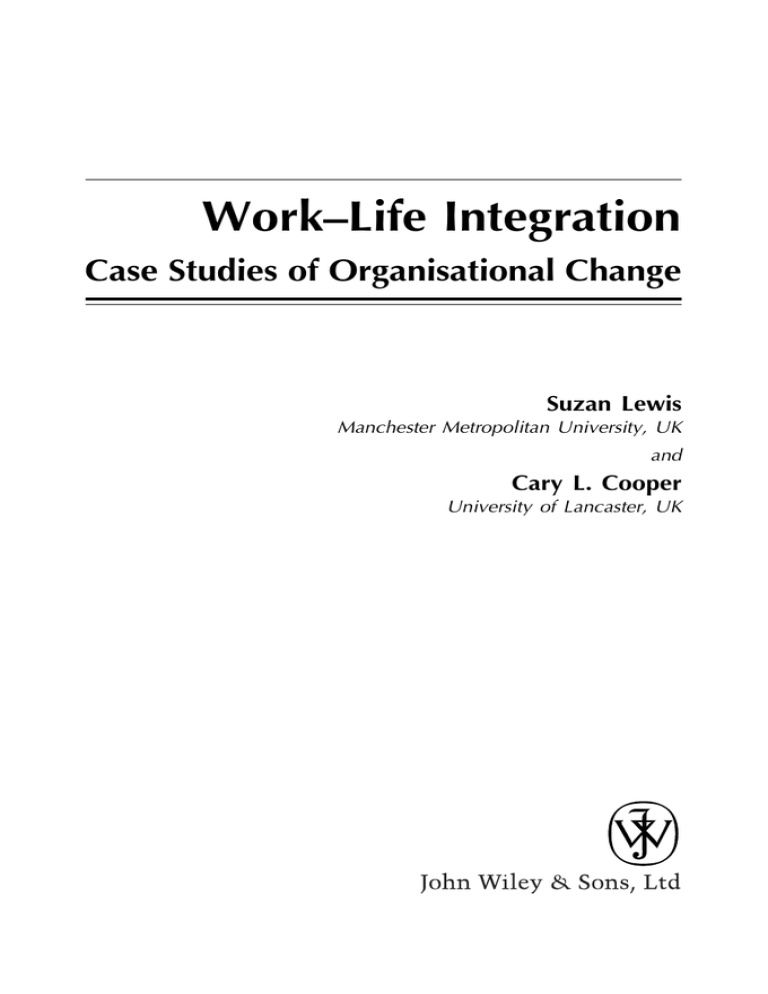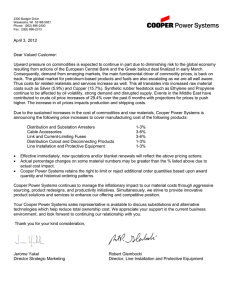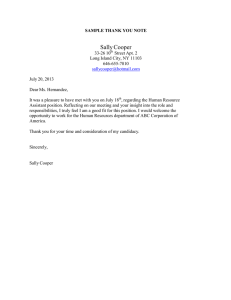
Work–Life Integration
Case Studies of Organisational Change
Suzan Lewis
Manchester Metropolitan University, UK
and
Cary L. Cooper
University of Lancaster, UK
Work–Life Integration
Case Studies of Organisational Change
Work–Life Integration
Case Studies of Organisational Change
Suzan Lewis
Manchester Metropolitan University, UK
and
Cary L. Cooper
University of Lancaster, UK
Copyright # 2005 John Wiley & Sons Ltd, The Atrium, Southern Gate, Chichester,
West Sussex PO19 8SQ, England
Telephone (þ44) 1243 779777
Email (for orders and customer service enquiries): cs-books@wiley.co.uk
Visit our Home Page on www.wiley.com
All Rights Reserved. No part of this publication may be reproduced, stored in a retrieval system or
transmitted in any form or by any means, electronic, mechanical, photocopying, recording, scanning or
otherwise, except under the terms of the Copyright, Designs and Patents Act 1988 or under the terms of
a licence issued by the Copyright Licensing Agency Ltd, 90 Tottenham Court Road, London W1T 4LP, UK,
without the permission in writing of the Publisher. Requests to the Publisher should be addressed
to the Permissions Department, John Wiley & Sons Ltd, The Atrium, Southern Gate, Chichester, West
Sussex PO19 8SQ, England, or emailed to permreq@wiley.co.uk, or faxed to (þ44) 1243 770620.
Designations used by companies to distinguish their products are often claimed as trademarks. All brand
names and product names used in this book are trade names, service marks, trademarks or registered
trademarks of their respective owners. The Publisher is not associated with any product or vendor mentioned
in this book.
This publication is designed to provide accurate and authoritative information in regard to the subject
matter covered. It is sold on the understanding that the Publisher is not engaged in rendering
professional services. If professional advice or other expert assistance is required, the services of a
competent professional should be sought.
Other Wiley Editorial Offices
John Wiley & Sons Inc., 111 River Street, Hoboken, NJ 07030, USA
Jossey-Bass, 989 Market Street, San Francisco, CA 94103-1741, USA
Wiley-VCH Verlag GmbH, Boschstr. 12, D-69469 Weinheim, Germany
John Wiley & Sons Australia Ltd, 33 Park Road, Milton, Queensland 4064, Australia
John Wiley & Sons (Asia) Pte Ltd, 2 Clementi Loop #02-01, Jin Xing Distripark, Singapore 129809
John Wiley & Sons Canada Ltd, 22 Worcester Road, Etobicoke, Ontario, Canada M9W 1L1
Wiley also publishes its books in a variety of electronic formats. Some content that appears in print
may not be available in electronic books.
Library of Congress Cataloging-in-Publication Data
Lewis, Suzan.
Work-life integration : case studies of organizational change / Suzan Lewis and Cary L. Cooper
p. cm.
ISBN 0-470-85344-1 (hbk) – ISBN 0-470-85343-3 (pbk)
1. Work and family – Case studies. 2. Organizational change – Case studies.
I. Cooper, Cary L. II. Title.
HD904.25.L48 2005
2004022951
306.3 0 6 – dc22
British Library Cataloguing in Publication Data
A catalogue record for this book is available from the British Library
ISBN 0-470-85344-1 (hbk)
ISBN 0-470-85343-3 (pbk)
Project management by Originator, Gt Yarmouth, Norfolk (typeset in 11/13pt Times)
Printed and bound in Great Britain by TJ International Ltd, Padstow, Cornwall
This book is printed on acid-free paper responsibly manufactured from sustainable forestry
in which at least two trees are planted for each one used for paper production.
Contents
About the Authors
vii
Foreword by Professor Ronald J. Burke
ix
Foreword by The Rt. Hon. Patricia Hewitt, MP
xiii
Acknowledgements
xvii
Chapter 1
Case Studies and Organisational Learning
1
Chapter 2
The Xerox Corporation
28
Chapter 3
Energyco
44
Chapter 4
Proffirm—The Professional Practice Firm
58
Chapter 5
Printco
71
Chapter 6
Recruitco
86
Chapter 7
Adminco
95
Chapter 8
Charityco
111
vi
Chapter 9
CONTENTS
A Long-term View
119
Appendix A Work–Life Integration Change Process
127
Appendix B Work–Personal Life Harmonisation: Visions and
Pragmatic Strategies for Change
129
References
159
Index
163
About the Authors
PROFESSOR SUZAN LEWIS
Suzan Lewis is Professor of Organizational and Work–Life Psychology
at Manchester Metropolitan University, and a Director of the Work–
Life Research Centre. She is a founding editor of the international
journal Community, Work and Family. Since the 1980s she has been
researching and writing about work and personal life issues, with a
particular focus on workplace flexibility and culture and organisational
change. She has directed many national and international research
projects on work–personal life issues including a current EU study of
‘‘gender, parenthood and the changing European workplace’’. The
numerous publications of which she is author or co-author include,
for example, Dual-Earner Families: International Perspectives (Sage,
1992), The Work–Family Challenge: Rethinking Employment (Sage,
1996) and Young Europeans, Work and Family (Sage, 2002). She has
also undertaken consultancy and training on work–personal life issues,
flexible working and organisational change in the UK, USA and Japan.
viii
ABOUT THE AUTHORS
PROFESSOR CARY L. COOPER, CBE
Cary L. Cooper is Professor of Organizational Psychology and Health,
Lancaster University Management School and Pro-Vice-Chancellor
(External Relations) at Lancaster University. He is the author of over
100 books (on occupational stress, women at work, and industrial and
organisational psychology), has written over 400 scholarly articles for
academic journals, and is a frequent contributor to national newspapers, TV and radio. He is currently founding editor of the Journal
of Organizational Behavior and co-editor of the medical journal Stress
and Health (formerly Stress Medicine). He is a Fellow of the British
Psychological Society, the Royal Society of Arts, the Royal Society of
Medicine, the Royal Society of Health and an Academician of the
Academy for the Social Sciences. Professor Cooper is the President of
the British Academy of Management, is a Companion of the Chartered
Management Institute and one of the first UK-based Fellows of the
(American) Academy of Management (having also won the 1998 Distinguished Service Award for his contribution to management science
from the Academy of Management). In 2001, he was awarded a CBE in
the Queen’s Birthday Honours List for his contribution to organisational health. He holds Honorary Doctorates from Aston University
(DSc), Heriot-Watt University (DLitt), Middlesex University (Doc.
Univ) and Wolverhampton University (DBA).
Professor Cooper is the editor ( jointly with Professor Chris Argyris of
Harvard Business School) of the international scholarly Blackwell Encyclopedia of Management (12-volume set), and the editor of Who’s Who
in the Management Sciences. He has been an advisor to two UN
agencies: the World Health Organization and the International
Labour Organisation; he published a major report for the EU’s European Foundation for the Improvement of Living and Work Conditions
on Stress Prevention in the Workplace; and is a special advisor to the
Defence Committee of the House of Commons on their Duty of Care
enquiry. Professor Cooper is also the President of the Institute of Welfare Officers, Vice-President of the British Association for Counselling
and Psychotherapy, an Ambassador of the Samaritans and Patron of
the National Phobic Society.
Foreword
by Professor Ronald J. Burke
Interest in the interplay of work and family has increased steadily over
the past 20 years. What was historically seen as a woman’s issue has
come to occupy an important concern for men, families and organisations. Men have families too and organisations employ men and women
with lives outside of the workplace.
Several broad and widespread demographic and economic factors have
increased the salience of work and family. There are now more women
in the workforce. There are more dual-earner families as well as more
single-parent households. There has simultaneously been an intensification of work. More women and men are working longer hours and
reporting greater demands in their workplaces. The downsized, restructured, outsourced, networked and allianced organisation now requires
more from fewer employees as they struggle with heightened worldwide
competition, and more demanding customers in an environment where
speed and cost have become more important. Technological and telecommunications advancements have made it possible to work 24/7 from
anywhere. Work and family have become particularly problematic for
managers and professionals performing knowledge work—an increasing
percentage of the workforce. These employees now work harder to
x
FOREWORD
maintain family income in response to uncertain feelings about their
future security and to keep up with or ahead of the Joneses. Work
and family has become a pressing concern for men, women, families
and organisations as a result.
Our views on work and family have also evolved and developed during
this time. The early writers viewed the two spheres as conflicting—work
conflicts with family and family conflicts with work. Not surprisingly,
the research showed work–family conflict to be more widespread and
have a more negative impact on employees than did family–work
conflict.
The first proposed solution to the problem of conflict was the notion of
work–family balance: work and family should be balanced. Balance, as
a concept, became problematic for some, however, since balance suggests a 50/50 investment. Some individuals might find balance in a 60/40
arrangement.
In addition, achieving balance implies taking away from one sphere and
applying it to the other. Balance also suggested a similar solution for
everyone—a 50/50 investment. Balance also suggests that work is not a
part of one’s life but something separate. The balance notion also leads
to a quick-fix solution to work–family conflict.
More current thinking frames the work–family issue in terms of integration or harmonisation. These terms legitimise a number of different
work–family investments or arrangements and apply to single employees without partners or children who still work, have families and
personal lives outside of the workplace. Work and family can in fact be
mutually reinforcing. And some employees can integrate or harmonise
their work and family by choosing to keep them quite separate.
Organisational responses designed to address work–family concerns
began with the development and articulation of work–family policies
supportive of the family. These included such initiatives as flexible work
hours, telecommuting, part-time work, childcare referrals, extended
maternity benefits and paternal leaves. The evidence, however,
showed these policy initiatives to be only moderately helpful in addressing work–family concerns. Work–family policies and programmes
were often poorly communicated to employees. Some managers were
FOREWORD
xi
minimally supportive of these policies and programmes. There was also
the suspicion that employees using family-friendly policies and programmes were seen as lacking commitment to their organisations and
were punished in subtle ways.
A more promising avenue to address work and family concerns seemed
to lie in changing workplace cultures, structures and approaches to
work and working. This is the subject of the present series of case
studies organised by Suzan Lewis and Cary Cooper. This collection is
unique in many ways. Other writers have described work–family best
practices—those policies and programmes developed to address
work–family concerns and how they might benefit employees and
organisations. Some writers have also linked the presence and use of
work–family policies and programmes with a limited set of personal and
organisational outcomes, such as levels of work–family conflict and
both work and family satisfaction. Lewis and Cooper emphasise,
instead, the process of how organisations attempted to change their
cultures and structures to be more supportive of work–family integration and the critical role of organisational learning in these efforts.
Lewis and Cooper clearly lay out why organisations must change to
better meet the needs of today’s workforce.
These case studies highlight the different paths organisations have taken
in grappling with work–family issues. Lewis and Cooper also distil some
common principles of organisational change that are likely to apply to
any organisation interested in experimenting and learning to become
more supportive of work, family and personal well-being.
There are other insights offered in these case studies that are, on the one
hand, interesting and useful to practice and, on the other hand, could be
discouraging, especially for those who underestimate the complexity of
organisational change and seek quick fixes. First, efforts to change
organisational culture, structures and approaches to work and working
are likely to require considerable resources and a long time frame.
Second, the dual agenda approach, which emphasises both work performance and personal quality-of-life issues simultaneously, appears to
hold much promise. Third, all the work–family experiments chronicled
in these case studies have potential for further learning. Consistent with
bringing about changes in any organisational process or system, bringing about successful changes in an organisation’s culture and structure
xii
FOREWORD
to support work–family harmonisation is a difficult undertaking,
although the cases highlight the many potential benefits of doing so.
While many managers and professionals complain about work interfering with family, they choose to do nothing about it. In addition, employing organisations in industrialised countries continue to stress and
reward task competencies over relationship competencies. Managers
seem to be oblivious to new human resource management practices
shown to meet both performance needs and employee well-being
needs. It is not surprising that progress in addressing work and family
has been slow. Fortunately, one can learn much from the change efforts
described in this collection that were only partially successful. Lewis and
Cooper distil change principles at the end of each case study that, if
embraced, will increase the success rate of all future change efforts in
this area.
Lewis and Cooper quite accurately place work and family issues as a
societal concern. Many women and men in all industrialised countries
experience work–personal life harmonisation difficulties and dissatisfaction. Although various countries have made different levels of progress
and employed varied approaches, new thinking is needed here to move
forward. This will, of necessity, involve challenging the priority of
profits above people, the powerlessness that many individuals feel, the
search for quick-fix solutions and the lack of collaboration among key
stakeholders (e.g., governments, organisations, trade unions and professional associations, communities, families and individuals).
More people today want a life beyond work. Employees can work more
effectively if they can integrate their work, families and personal lives in
more satisfying ways. This becomes a win–win situation for all involved.
This collection moves us in this direction.
Ronald J. Burke
Professor of Organizational Behavior
Schulich School of Business
York University
Canada
Foreword
by The Rt. Hon. Patricia Hewitt, MP
Work–life balance is a phrase that hardly causes business people to raise
an eyebrow these days. Our best business leaders talk positively to their
employees, to prospective staff and in public about the benefits they
offer to their staff and, in turn, the flexibility that accrues to their
business.
Yet the landscape of this debate has changed vastly from how it appeared just a decade ago. In 1993, when I wrote a book called About
Time, setting out the challenges in the area of work and family life, the
phrase ‘‘work–life balance’’ was not in the vocabulary of most business
people—nor of most politicians! It was an aspect of our lives that public
policy and our workplaces largely failed to address. What a contrast
these days—now anyone who picks up a newspaper or magazine, or
applies for a new job, is likely to be confronted by ‘‘flexible working’’
and work–life balance.
The authors have long championed the case for work–life balance and
in this book they have looked in detail at which factors enable firms to
implement work–life balance politics successfully. This is a helpful contribution as it also helps us to understand how best to introduce these
xiv
FOREWORD
into a workplace, and what might be the problem areas and how to get
round them.
In Government, we have been promoting work–life balance and flexible
working opportunities for some time now, demonstrating that there is a
business case for work–life balance. In the future we want everyone to
feel that they have more choice and control over their working lives.
Flexible working opportunities benefit everyone: employers, employees
and their families. Many employers tell us that it makes good business
sense to provide flexible working opportunities for their staff. Using
case studies, a body of research evidence, and a dedicated website, the
DTI has highlighted the real business benefits reported to us by companies who have considered, and then implemented, alternative ways of
working.
The business case for work–life balance for both employers and employees is clearly shown by the facts:
. 71% of employers who operate flexible working report that it has a
positive impact on management–employee relations, employee motivation and commitment (69%), and labour turnover (54%).
. Almost half of employers report improvements in productivity, absenteeism and recruitment.
. There are also evident qualitative benefits for employers and their
employees, chiefly improved morale and reduced levels of stress.
The DTI supports business and individuals interested in work–life
balance in a number of ways. As well as raising awareness through
advertising and the media, we have provided financial assistance to a
number of projects in workplaces around the country, amounting to
almost 450 employers with over a million employees between them.
But our work continues—we are now promoting work–life balance as
part of the overall way in which companies can become a highperformance workplace.
This book is a useful exploration of how organisations implement
work–life balance policies. The Government has helped raise the awareness of businesses of the benefits of enabling staff to work in new ways
FOREWORD
xv
enabling them to have more choice and control about their work.
We will continue to explore ways of helping firms to discover the
benefits of adopting good practice particularly when dealing with
their most valuable resource, people.
The Rt. Hon. Patricia Hewitt, MP
November 2004
Acknowledgements
Many people have contributed to this book in important ways. In particular, Rhona Rapoport has been inspirational, as always. We are
grateful for her clear-sighted, often challenging and always thoughtprovoking comments on earlier drafts of the book. Thanks go also to:
Gill Carter, Jo Duff, Ian Greenaway, Jo Morris, Liz Raczi, Karen Silk,
Ragnhild Sohlberg, Annamarie van Iren and Uracha Chatrakul Na
Ayudhya for their insights and reflections on the case studies.



